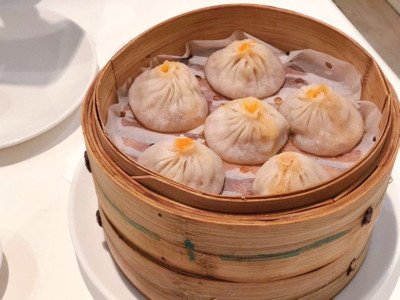Singapore: Indian Fried Noodle Recipe 🥁🥁🥁🥁🥁
/Singapore is a splendid city, sort of a perfect Big Apple, with grand marble sidewalks, Moehn faucets gleaming in meticulous subway restrooms, and a tropical rain forest within walking distance from the designer shops along Orchard Row.
A modest Buddhist shrine is tucked into the wall of the parking garage, white stucco churches hold court down town and colorful mosques and Hindu temples dot the realms of Little India and Arab Street. The exquisite blending of cultures – British, Chinese, Indian, Malaysian and Indonesian to name a few -- is reflected in the savory cuisine of this sophisticated city.
One way to sample it is at the many Hawker Centres, open-air food courts, hot, stuffy, and noisy, but with an array of wonderful delicacies. Lau Pa Sat, a massive antique wooden pavilion in the center of the business district, looks a lot like the old Victorian band stands from small town America, and indeed it is a symphony of taste and smell.
There we feasted upon Indian Mee Goreng (Spicy Indian-style Fried Yellow Noodles), Satay Ayam (Skewered Chicken Chunks with Peanut Sauce), Teochew-style White Fish Marinated in Rice Wine, Stingray Steamed in a Banana Leaf, Sambal Kangkung (Stir-fried Spicy Greens) that are a cross between spinach and baby celery, and closed with Mango Pudding. The food is terrific and cheap, but there are more reasons to enjoy, according to Kemboja from Singapore’s Unoffical Food Page Makan Time in Singapore:
“I can put cockle/shrimp shells on the table and nobody care a hoot.”
“I can shout at the auntie for my sugar-cane juice and she wouldn’t think it is rude.”
“I can feed cats rubbing at my feet.”
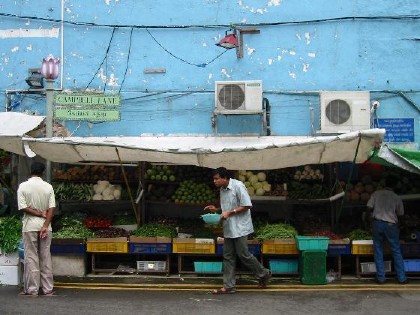
In Little India I watched deft fingers toss paper-thin dough into the air and then onto an oiled griddle to make the Indian Pancake called Roti Prata. One Singapore favorite has this pancake filled with a tangy blend of lamb and spices to make a crispy delight called Murtabak. And speaking of spices, you haven’t lived until you have taken the walk down Serangoon Road to one of the last of the spice grinding shops where the aroma is almost as satisfying as eating an entire meal.
But after a day of fighting the throngs and the tropical heat, worn out from negotiating the price of various baubles that I knew I would have to fight to cram into my suitcase, it was a pleasure to return to the sleek air conditioned comfort of the Cafébiz at the Traders Hotel, where the breakfast buffet was an around the world tour, and the show kitchen a magical performance of culinary feats.
The sleek cool comfort of the breakfast buffet guaranteed my morning would be off to a great start. Their exotic array of fresh fruits began with dragon fruit, a Viet Nam native, whose triangular outer leaves resemble a dragon’s scales. The fruit itself is firm white sweetness, dotted with flecks of black. I peeled back the deep burgundy skin of a mangosteen to reveal an orb of honeyed delight.
The rambutans looked like large, hairy strawberries with white, crunchy flesh beneath their awesome façade. A special knife had diced the flesh of aloe vera into small cubes like Liz Taylor sized diamonds, and their iridescent glow was as memorable as their natural light sweetness --kind of like eating God’s guilt-free version of Jujubes, the movie candy that was part of my Saturday Matinee ritual.
There were unexpected breakfast items, too – for me at least – such as miso, (Japanese soup), green salad, steamed broccoli and mushrooms in oyster sauce, smoked salmon, as well as all sorts of noodle and rice dishes with an assortment of exotic condiments to customize them. Great vats of congee, a sort of rice porridge not unlike cream of wheat or grits, disappeared as fast as Southern gravy, while plump white dim sum cuddled underneath straw warmers like so many nesting eggs.
Executive Chef Wong Fook Hoi, an exceptionally tall, sleek man who belies the adage, “Never trust a skinny chef,” was kind enough to share some of his expertise with me. He has won many awards during the Singapore Asia Culinaire shows as well as a Gold with the Singapore National Team at Ika Olympic Culinaire in Germany. Trained at the Culinary Institution of America in California, the Singapore native has also traveled and worked extensively in Mongolia, Japan, London, Bombay, China, and Indonesia.
He explained the various kinds of tofu or soybean curd. The soft raw tofu, silken in texture, is a blank slate waiting for various spices to give it identity. (I broke tradition and sweetened it with a little sugar for what tasted very much like custard or cream cheese.) The hard tofu is made with egg. “Kway teow,” which is wide, white and thin, is usually fried in lard and added to soup or main dishes, often as a meat substitute. The thicker version, called “horfun,” Cantonese in tradition, is much thicker.
He also patiently gave a quick course in the various kinds of noodles, patiently waiting for me to get the spelling or pronunciation right, “Beehoon” is the Chinese rice noodle, usually fried or used in soup . “Mee,” Indian style yellow noodles, get their color from egg yolks and alkaline water.
Singapore’s spin on curry is slightly different from the Indian version, depending upon shallots, lemon grass, blue ginger, garlic, and tumeric for its yellow color. Shrimp paste and the sour fruit, tamarind, are also frequent players.
I listened with rapt attention as Chef Wong Fook Hoi detailed the making of the exotic blends and afterward even purchased several recipe books spelling out the procedures. But I was feeling not quite up to the job and also unsure where I might find Tamarind juice, fenugreek seeds, as well as somewhat unwilling to concoct my own belacan (shrimp paste), when my Singapore friend, a busy professional, let me in on her secret. Just as I buy my favorite Texas barbecue sauce rather than make it, so does she with her Singapore delicacies.
At six that evening, I was in for a show. Twenty-six year old David Wan Jun Cheng, has spent 3 1/2 of those years learning the traditional art of “La-Mian,” or hand-made noodles. He started out with an innocuous slab of dough and began to braid it, twisting it through the air with an assured finesse that reminded me of rodeo calf ropers. Then his magical hands pulled out more and more delicate golden strands as he worked like a weaver unraveling silken threads. His finest noodle can be threaded through the eye of a needle!
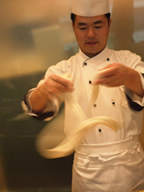
Ever-gracious Traders Hotel Communications Manager,Wong Wai Ling knew I was a mystery writer and also shared my love of Grand Dame Agatha Christie. A gentle soft-spoken woman, she was nevertheless quite enthusiastic in pointing out the various murders that could be perpetrated within Traders’ splendid dining hall. Chef David showed me how he sliced noodles with an especially lethal looking flat knife. Wai Ling gave me a knowing smile. The new Brazilian specialty, “Grill a la Churrasco,” featured large steel skewers of grilled meat brought to the table and sliced directly onto the diner’s plate. All sorts of possibilities there!
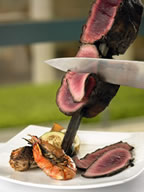
Even the prolific display of tandoori dishes of Northern India, baked at high heat in clay ovens, such as chicken and lamb tandoori, fish tikka, and naan bread, looked formidable on their tall skewers.
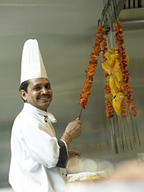
And the relatively tame bamboo skewers featured in the “Dip-Dip” stations could also be lethal if targeted to the right soft flesh, our murderous minds agreed. But with such wonderful fare, even the most foul of villains would have to relent. Prawn, fish, salmon, scallops, mushrooms, chicken fillet with asparagus are just a few of the 25 varieties of fresh food ready for cooking in hot pots and then savored with a range of 15 exotic sauces such as sambal chili, satay, black pepper, mint jalapeno, and Thai sweet chili, to name a few.
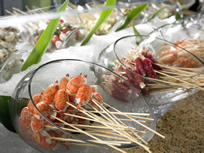
If you can, book your trip to Singapore right now. The city is lovely with the most heavenly collection of orchids in the world; the people are sweet, intelligent, with a special wry humor, and the food is amazing.
If you can’t get there right now, settle instead for a virtual tour and sample this wonderful Singapore dish.
Mee Goreng / Indian Fried Noodle
A Classic *Mamak stir fry. Lots of fresh vegetables, a little minced mutton and high heat. The result? A dish with just a touch of the desired burned flavor. Served with a side dish of fresh cucumber and tomato sauce ... hmm ... heavenly!!!
*Note: Mamak is a friendly term used to address Muslim Indian.
tandoori.
Thick yellow noodles fried with minced mutton, potatoes, tomatoes, bean sprouts and served with cucumber.
Ingredients
1 large sliced green chili
1 tablespoon freshly ground red chili paste or hot chili sauce
3 tablespoons tomato sauce
1 ripe quartered tomato
1 large boiled and diced potato
1/4 lb. minced mutton or diced hard bean curd for a vegetarian version
1 sliced onion
1/4 cup bean sprouts
1/4 cup finely sliced cabbage
1 lb. yellow noodles
1/4 cup oil
2 eggs, slightly beaten
Salt and pepper to taste
Sprinkle of sugar, if desired
Method
Heat oil and fry onion well, add minced mutton (or the diced bean curd), tomatoes, potatoes and cabbage. Next, throw in noodles and bean sprouts and fry for a short while. Throw in green chilies, red chili and fry briefly. In the center of the wok, heat oil, and put in the eggs, scramble and mix with noodles thoroughly. Season with salt, sugar, tomato sauce and chili sauce.
Served with sliced cucumber and tomato sauce.
Recipe Source: Makan Time in Singapore 1998; thian@blauwbrug.nl








